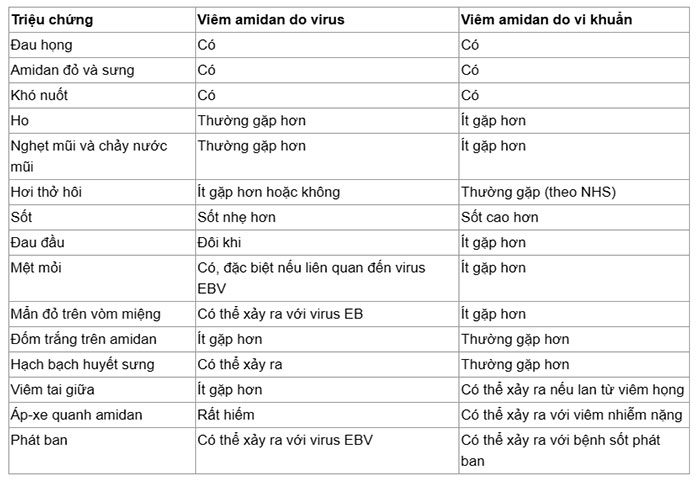Tonsillitis can occur due to bacteria or viruses, with the most common sensation being a sore throat.
What You Need to Know About Tonsillitis
Tonsillitis is a common health condition that affects both adults and children. It can be caused by various factors, with bacteria and viruses being the two primary culprits. Understanding the differences in treatment for bacterial versus viral tonsillitis requires a clear understanding of the underlying cause of the condition.
Here are some key differences between viral and bacterial tonsillitis, including symptoms, treatment, causes, and some risk factors.
1. What are the differences in symptoms between viral and bacterial tonsillitis?
Generally, it can be challenging to distinguish between bacterial and viral tonsillitis based on symptoms alone. Different strains of viruses and bacteria may present with unique characteristics, which is why testing is important. The primary symptom of both viral and bacterial tonsillitis is a sore throat. Both types of tonsillitis can also cause redness, swelling, and pain in the tonsils, along with difficulty swallowing.
Cough, nasal congestion, fever: If you have viral tonsillitis, such as from the common cold or flu, your symptoms may be milder compared to bacterial causes. Patients may also experience coughing, nasal congestion, and runny nose. A mild fever can occur with viral tonsillitis, typically ranging from 100.4°F to 102°F.
Both viral and bacterial tonsillitis can cause coughing, but coughs associated with viral infections often come with a hoarse voice (voice changes).

What are the differences in symptoms between viral and bacterial tonsillitis? (Photo: ST).
Fatigue, red spots (unilateral) on the palate: Of course, tonsillitis will cause fatigue in patients, but if you are frequently fatigued, consider testing for the Epstein-Barr virus (EBV) – the virus that causes mononucleosis, commonly known as mono. This virus is a common cause of tonsillitis in adolescents and can present with prolonged symptoms lasting weeks, including fatigue, sore throat, swollen tonsils, fever, swollen lymph nodes in the neck and armpits, and headaches. Some EBV infections may present with a rash on the palate or skin rashes.
Bad breath: Bacterial tonsillitis tends to be more severe, and you may notice bad breath, according to NHS guidelines. Several types of bacteria can cause tonsillitis, but the most common is Group A Streptococcus.
White patches on the tonsils: Additionally, bacterial tonsillitis often presents with small white patches filled with pus on the tonsils; this symptom is more common with bacterial infections than with viral tonsillitis.
Swollen lymph nodes: Using your index and middle fingers, gently press along both sides of your neck, under the jawline, and behind the ears. Feel for any lumps that are hard or soft, roughly the size of your pinky nail. This could indicate swollen lymph nodes. While your lymph nodes can swell anytime your body is fighting an infection, swollen nodes are more commonly associated with bacterial infections.
Watch for abscesses in the tonsils: Peritonsillar abscesses are complications of tonsillitis or streptococcal pharyngitis, and symptoms will be similar to these two conditions. Seek medical attention if you experience symptoms such as worsening pain on one side of the throat, difficulty swallowing, changes in voice (a “hot potato” voice), swollen lymph nodes, tonsils that are red and enlarged on one side, unusual bad breath, or the uvula appearing pushed to one side.
Below is a comparison table of some symptoms of viral and bacterial tonsillitis based on compiled data, noting that one should not rely solely on these signs to determine whether tonsillitis is viral or bacterial, and self-treat without a doctor’s recommendation.

2. What are the causes of viral and bacterial tonsillitis?
First, viral tonsillitis is generally more common than bacterial tonsillitis.

Each type of virus or bacteria causing tonsillitis has different symptom characteristics. (Photo: ST).
Causes
– Viral tonsillitis typically occurs due to common respiratory viruses, including:
- Common cold virus (rhinovirus).
- Influenza virus.
- Adenovirus, which causes cold-like symptoms and sore throat.
- Epstein-Barr virus, the cause of mononucleosis.
- Coronavirus, including strains causing COVID-19.
- Herpes simplex virus, which can cause tonsillitis, particularly in children.
These viruses spread through droplets from person to person via coughing, sneezing, talking, or close contact. Viral tonsillitis can develop as part of pharyngitis or upper respiratory tract infections.
– The cause of bacterial tonsillitis is often due to streptococcal bacteria, specifically Group A streptococcus, along with aerobic and anaerobic strains. Group A Streptococcus is the most common cause of bacterial tonsillitis.
Risk Factors
– Individuals at high risk for viral tonsillitis typically include:
- Children and adolescents, as their immune systems are not yet fully developed.
- Individuals with weakened immune systems, including both adults and children.
- Those frequently exposed to environments with circulating viruses, such as schools, daycare centers, or crowded workplaces.
- People living in or traveling to areas with active flu outbreaks or other infectious diseases.
Avoiding close contact with sick individuals, maintaining personal hygiene, and taking preventive measures such as timely vaccinations can help reduce the risk of viral tonsillitis.
Individuals at high risk for bacterial tonsillitis typically include:
- Children and adolescents aged 5 to 15 years, due to their developing immune systems and increased exposure to pathogens at school.
- Those with weakened immune systems due to medical conditions or treatments such as chemotherapy, radiation therapy, or immunosuppressive medications.
- Individuals living or working in crowded environments, such as schools, daycare centers, or healthcare facilities, where bacteria can spread easily.
- Those with a history of bacterial tonsillitis or other upper respiratory infections.
It is important to note that while individuals in these groups are at higher risk, bacterial tonsillitis can occur at any age.
3. Treatment for Viral and Bacterial Tonsillitis
As mentioned above, how tonsillitis is treated will depend on the underlying cause. In most cases, the symptoms of tonsillitis will gradually resolve within 3 to 7 days, regardless of whether the infection is viral or bacterial. Symptoms of viral tonsillitis, in particular, may show noticeable improvement within the first 3 to 4 days.
According to Healthline, there are no specific treatments if you have viral tonsillitis. However, if the infection is bacterial, antibiotics may be prescribed.
When taking antibiotics for bacterial tonsillitis, patients should be mindful to take and complete the entire course as prescribed by their doctor, even if symptoms show signs of improvement. Stopping antibiotics abruptly without medical guidance can prevent the bacterial infection from being eradicated and contribute to antibiotic resistance.

Bacterial tonsillitis may require antibiotics. (Photo: Internet).
Supportive Care
Whether you have viral or bacterial tonsillitis, here are some supportive measures to help you feel more comfortable:
- Rest more.
- Drink plenty of water.
- Eat soft, easy-to-swallow foods, and consider smaller meals throughout the day if necessary.
- Drink warm water or suck on cold foods like ice cream to soothe a sore throat.
- Stay hydrated with a humidifier.
- Gargle daily with salt water.
- Take over-the-counter pain relievers.
When is Tonsillectomy Necessary?
The decision to perform a tonsillectomy should be based on a doctor’s assessment of the specific health condition of each patient. However, children under 5 years old and adults over 45 should limit surgery. This is because children under 5 have weaker immune systems, and adults over 45 may experience higher risks of bleeding and infections due to scarred tonsils or other underlying health issues such as cardiovascular diseases or hypertension. A doctor may consider recommending tonsillectomy if:
- The patient experiences at least 5 episodes of bacterial tonsillitis within a year.
- If they suffer from severe tonsillitis at least 7 times a year, 5 times a year for 2 consecutive years, or 3 times a year for 3 consecutive years.
- When tonsillitis leads to serious complications such as peritonsillar abscess or difficulty breathing due to enlarged tonsils (snoring, sleep apnea), middle ear infections, sinusitis, or other severe complications like rheumatic fever, arthritis, or glomerulonephritis.
- Tonsillitis persists without improvement after 4 to 6 weeks of aggressive treatment.
- When there are many recesses in the tonsils containing secretions leading to bad breath (tonsil stones), a feeling of obstruction while swallowing, or suspicion of a malignant tumor.
Understanding the signs and treatment methods will help patients take preventive measures and intervene promptly, reducing the risk of complications and improving health when suffering from tonsillitis. It can be difficult to determine whether you have viral or bacterial tonsillitis just by observation; laboratory tests like throat cultures may be necessary for confirmation.



















































